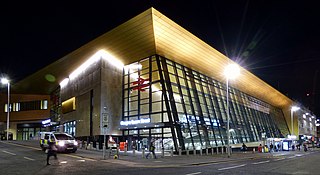
Glasgow Queen Street is a passenger railway terminus serving the city centre of Glasgow, Scotland. It is the smaller of the city's two mainline railway terminals and is the third busiest station in Scotland behind Central and Edinburgh Waverley.

The Glasgow–Edinburgh via Falkirk line is a mainline railway line linking Glasgow and Edinburgh via Falkirk in Scotland. It is the principal route out of the five rail links between Scotland's two biggest cities, hosting the flagship "Shuttle" service between Glasgow Queen Street and Edinburgh Waverley. A typical service calls at Glasgow Queen Street, Croy, Falkirk High, Haymarket and Edinburgh or Glasgow Queen Street, Falkirk High, Polmont, Linlithgow, Haymarket and Edinburgh.
The Edinburgh and Glasgow Railway was authorised by Act of Parliament on 4 July 1838. It was opened to passenger traffic on 21 February 1842, between its Glasgow Queen Street railway station and Haymarket railway station in Edinburgh. Construction cost £1,200,000 for 46 miles (74 km). The intermediate stations were at Corstorphine, Gogar, Ratho, Winchburgh, Linlithgow, Polmont, Falkirk, Castlecary, Croy, Kirkintilloch and Bishopbriggs. There was a ticket platform at Cowlairs. The line was extended eastwards from Haymarket to North Bridge in 1846, and a joint station for connection with the North British Railway was opened on what is now Edinburgh Waverley railway station in 1847.

Croy railway station serves the village of Croy – as well as the nearby town of Kilsyth and parts of Cumbernauld – in North Lanarkshire, Scotland. Located on the Glasgow to Edinburgh via Falkirk Line, 11+1⁄2 miles (18.5 km) northeast of Glasgow Queen Street. It is served by services on the Glasgow–Edinburgh mainline and services between Glasgow Queen Street and Stirling. Train services are provided by ScotRail.

Lenzie railway station is a railway station serving Lenzie and Kirkintilloch in East Dunbartonshire, Scotland. It is located on the Croy Line, 6+1⁄4 miles (10.1 km) northeast of Glasgow Queen Street. Trains on the Glasgow to Edinburgh via Falkirk Line pass Lenzie by. The station is served by ScotRail.

Bishopbriggs railway station is a railway station serving Bishopbriggs in East Dunbartonshire, Scotland. It is located on the Glasgow to Edinburgh via Falkirk Line, 3+1⁄4 miles (5.2 km) north of Glasgow Queen Street, but is currently only served by services on the Croy Line.
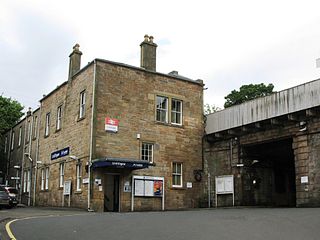
Linlithgow railway station is a railway station serving the town of Linlithgow in West Lothian, Scotland. It is located on the Glasgow to Edinburgh via Falkirk Line and is also served by ScotRail services from Edinburgh Waverley to Dunblane, and the daily train between Glasgow Queen Street and the Fife Circle Line.
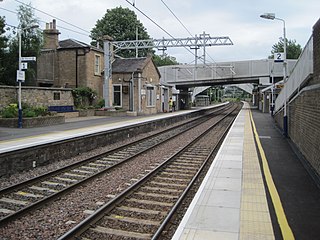
Polmont railway station is a railway station serving the village of Polmont, Scotland as well as the other Falkirk Braes villages. It is located on the Glasgow to Edinburgh via Falkirk Line and is also served by ScotRail services from Edinburgh to Stirling and Dunblane. It is the nearest station to much of the town of Grangemouth.
The Edinburgh–Dunblane line is a railway line in East Central Scotland. It links the city of Edinburgh via Falkirk to the city of Stirling and the town of Dunblane.
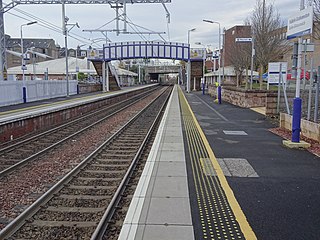
Falkirk Grahamston railway station is one of two railway stations serving the town of Falkirk in Scotland. It is located on the Edinburgh to Dunblane Line and also the Cumbernauld Line. Train services are provided by ScotRail. The "Highland Chieftain", the daily London North Eastern Railway service from London King's Cross to Inverness and vice versa also calls here.

Larbert railway station is a railway station serving Larbert near Falkirk, Scotland.

Stirling railway station is a railway station located in Stirling, Scotland. It is located on the former Caledonian Railway main line between Glasgow and Perth. It is the junction for the branch line to Alloa and Dunfermline via Kincardine and is also served by trains on the Edinburgh to Dunblane Line and long-distance services to Dundee and Aberdeen and to Inverness via the Highland Main Line.

Dunblane railway station serves the town of Dunblane in central Scotland. It is located on the former Scottish Central Railway, between Stirling and Perth and opened with the line in 1848. It is the northernmost station on the National Rail network to be electrified.

Cumbernauld railway station serves the town of Cumbernauld, Scotland. The station is managed by ScotRail and is located on the Cumbernauld Line, 14 miles (23 km) north east of Glasgow Queen Street station and the Motherwell to Cumbernauld Line, 11+3⁄4 miles (18.9 km) north of Motherwell. Trains serving the station are operated by ScotRail.
The Scottish Central Railway was formed in 1845 to link Perth and Stirling to Central Scotland, by building a railway line to join the Edinburgh and Glasgow Railway near Castlecary.

Alloa railway station is a railway station in the town of Alloa, Clackmannanshire, Scotland, which was re-opened on Monday, 19 May 2008.

The British Rail Class 380 Desiro is a type of electric multiple unit passenger train that operates on the National Rail network in Scotland, for ScotRail.
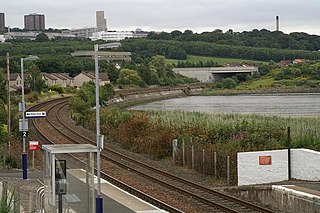
The Glasgow–Dundee line is a railway line linking Glasgow with Dundee via Stirling and Perth.
The Scotland Route Utilisation Strategy is a Route Utilisation Strategy, published by Network Rail in March 2007, the third RUS to be published. The railways in Scotland are divided into three strategic routes, namely Route 24, Route 25 (Highlands) and Route 26 together with parts of Route 8 and Route 18. The three strategic routes form the scope of Network Rail's Scotland Route Utilisation Strategy. Separate RUSs for the ECML and WCML encompass the relevant parts of routes 8 and 18. The Edinburgh Crossrail service, which provides a direct route between Stirling, Dunblane and Bathgate in the west to Newcraighall in the east, operates over part of the ECML east of Edinburgh Waverley to Portobello Junction.
The Edinburgh Glasgow Improvement Programme or EGIP was an initiative funded by Transport Scotland on behalf of the Scottish Government to increase capacity on the main railway line between Edinburgh and Glasgow, with new, longer electric trains running by 2017 and scheduled for full completion in 2019. It was expected to cost £742 million and delivered by Network Rail.















